Asteroid? Meteor? Meteorite? Rock? When you have access to an XRF instrument friends ask you to test all sorts of things!
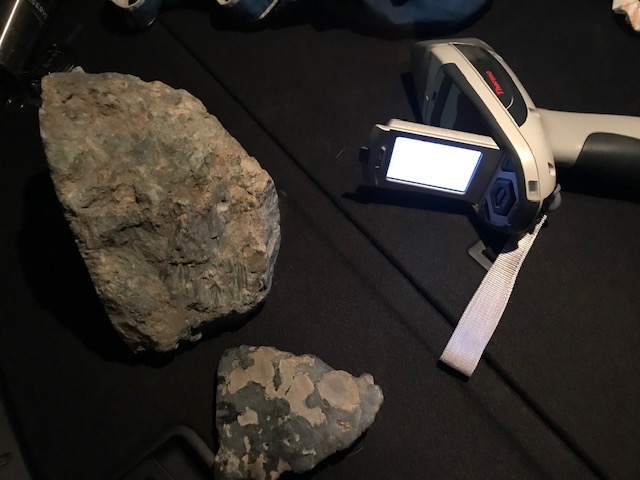
My friend Brit is trying to find out if this rock she found is actually from from outer space.
Yes. You read that right!
The rock seems to have several characteristics of a meteorite but is missing some other key characteristics and some characteristics it has aren’t quite as convincing as others to those who study the subject:
- It’s heavy as f’in s%$t.
- It tests positive for traces of Nickel, but the levels are on the low side.
- It is magnetic in parts.
- It has several shiny metal flakes in the “window” from the piece Brit cut off. [These are hard to see in photos but are very clear to see in person.]
- It’s missing the tell-tale outer layer (crust) one would expect on a meteorite because Brit scrubbed some of it off (and this is apparently something key to determining if a rock is a meteorite or not.)
- The overall physical appearance seems very much to be more like a meteorite than slag.
It also has some characteristics that are not consistent with it being a “meteor-wrong”:
- It has high levels of Iron but it also has spots that are high in Titanium AND Aluminum. [It is my understanding that a “meteor-wrong” [aka – slag] won’t have high aluminum and titanium in addition to Iron.]
- Based on what Brit told me it was found in the middle of a field in an area with rocks that had completely different physical characteristics.
So in order to facilitate this inquiry… we did a full set of XRF tests to various components of the large natural object, and took photos supporting those test results, and I am sharing them here on my blog for Brit – but also so I have a link to share on Facebook and Twitter in case one of my other friends can help her identify this rock found in the middle of a field [in which all the other rocks were “ordinary”, alike — and utterly dissimilar to this oddball] as a potential chunk of space debris!
In the 32 images on this post, the image with the circled section is the spot tested, followed by the test results for that spot (when using an XRF instrument.) Each test was done for at least 60 seconds. Two testing modes were used. Various different sections of the object were high positive for various different metals (Titanium, Aluminum or Iron for example).
Thank you for reading and for checking out the images — especially if you have expertise in the subject.
My understanding is that if this IS a meteorite it would likely be an “atypical” one, and might be quite valuable, so that would be super-cool for Brit — who lost her motorhome (where she lived) to a fire earlier this year in California.
Tamara Rubin
#LeadSafeMama
First, let’s start with some definitions [my kids have been schooling me on the subject, since they are my in-house experts on all things cosmic (“Ugh, Mom, if you’re holding it in your hand it can’t be an “ASTEROID” — don’t you know ANYTHING?!”)]:
Meteor
Asteroid
Meteorite
Reading Set One (Test All Mode):
- Barium (Ba): 168 +/- 69 ppm
- Zinc (Zn): 95 +/- 31 ppm
- Nickel (Ni): 542 +/- 116 ppm
- Iron (Fe): 184,000 +/- 4,900 ppm [18%]
- Vanadium (V): 81 +/- 40 ppm
- Titanium (Ti): 269 +/- 66 ppm
- Magnesium (Mn): 1,724 +/- 280 ppm

Reading Set Two (Test All Mode):
- Zinc (Zn): 193 +/- 41 ppm
- Nickel (Ni): 271 +/- 102 ppm
- Iron (Fe): 158,100 +/- 4,400 ppm [15%]
- Vanadium (V): 224 +/- 58 ppm
- Titanium (Ti): 2,287 +/- 162 ppm
- Magnesium (Mn): 1,920 +/- 307 ppm




Reading Set THREE (Test All Mode):
- Zinc (Zn): 165 +/- 32 ppm
- Nickel (Ni): 337 +/- 89 ppm
- Iron (Fe): 130,800 +/- 3,200 ppm [13%]
- Vanadium (V): 180 +/- 50 ppm
- Titanium (Ti): 2,418 +/- 148 ppm
- Magnesium (Mn): 1,038 +/- 227 ppm
Reading Set Four (Test All Mode):
- Zinc (Zn): 222 +/- 44 ppm
- Nickel (Ni): 424 +/- 116 ppm
- Iron (Fe): 222,900 +/- 6,000 ppm [22%]
- Vanadium (V): 460 +/- 68 ppm
- Titanium (Ti): 1,393 +/- 129 ppm
- Magnesium (Mn): 1,610 +/- 277 ppm

Reading Set FIVE (Test All Mode):
- Zinc (Zn): 226 +/- 42 ppm
- Nickel (Ni): 454 +/- 115 ppm
- Iron (Fe): 243,700 +/- 6,200 ppm [23%]
- Vanadium (V): 139 +/- 50 ppm
- Titanium (Ti): 718 +/- 97 ppm
- Magnesium (Mn): 2,144 +/- 278 ppm

Reading Set SIX (Test All Mode):
- Zinc (Zn): 241 +/- 38 ppm
- Nickel (Ni): 233 +/- 85 ppm
- Iron (Fe): 152,300 +/- 3,600 ppm [15%]
- Vanadium (V): 207 +/- 52 ppm
- Titanium (Ti): 1,896+/- 134 ppm
- Magnesium (Mn): 2,655 +/- 287 ppm

Reading Set SEVEN (Metals [Elec. Alloys w/Copper] Mode):
- Aluminum (Al): 785,600 +/- 4,600 ppm [78%]
- Zinc (Zn): 224 +/- 32 ppm
- Nickel (Ni): 317 +/- 80 ppm
- Iron (Fe): 194,600 +/- 4,000 ppm [19%]
- Titanium (Ti): 15,500+/- 1,000 ppm [1.5%]
- Magnesium (Mn): 2,219 +/- 231 ppm

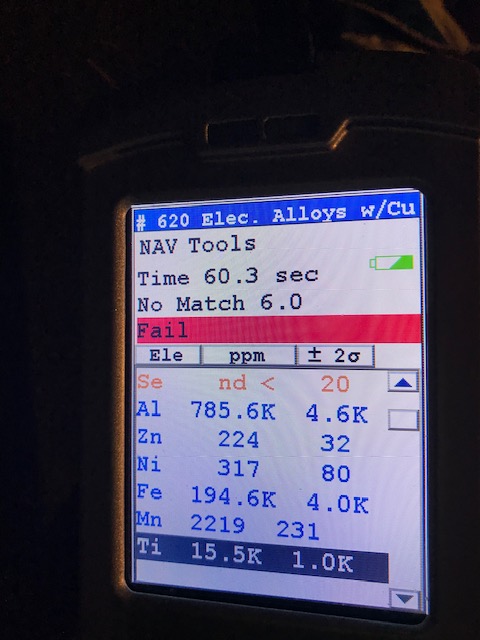
Reading Set EIGHT (Metals [Elec. Alloys w/Copper] Mode):
- Aluminum (Al): 798,300 +/- 4,200 ppm [79%]
- Zinc (Zn): 113 +/- 25 ppm
- Copper (Cu): 137 +/- 44 ppm
- Nickel (Ni): 440 +/- 87 ppm
- Iron (Fe): 198,200 +/- 4,100 ppm
- Magnesium (Mn): 1,459 +/- 206ppm

Reading Set NINE (Metals [Elec. Alloys w/Copper] Mode):
- Barium (Ba): 1,801 +/- 679 ppm
- Molybdenum (Mo): 2,440 +/- 336 ppm
- Zinc (Zn): 2,190 +/- 360 ppm
- Copper (Cu): 950 +/- 469 ppm
- Nickel (Ni): 4,848 +/- 919 ppm
- Cobalt (Co): 6,891 +/- 1,609 ppm
- Iron (Fe): 969,400 +/- 2,500 ppm [96%]
- Magnesium (Mn):6,092 +/- 721 ppm
- Titanium (Ti): 2,522. +/- 851 ppm

Never Miss an Important Article Again!
Join our Email List









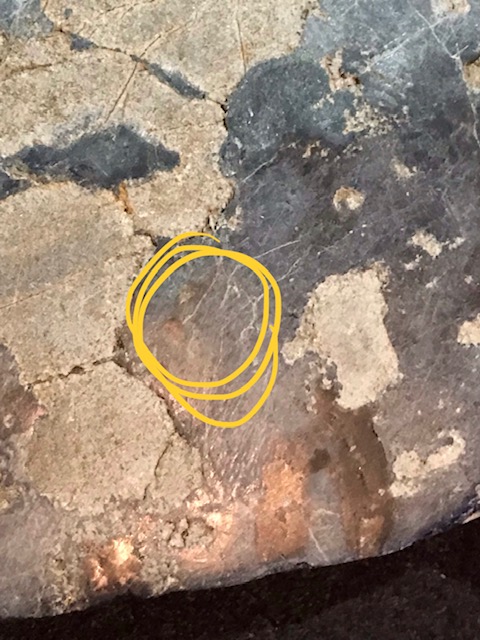
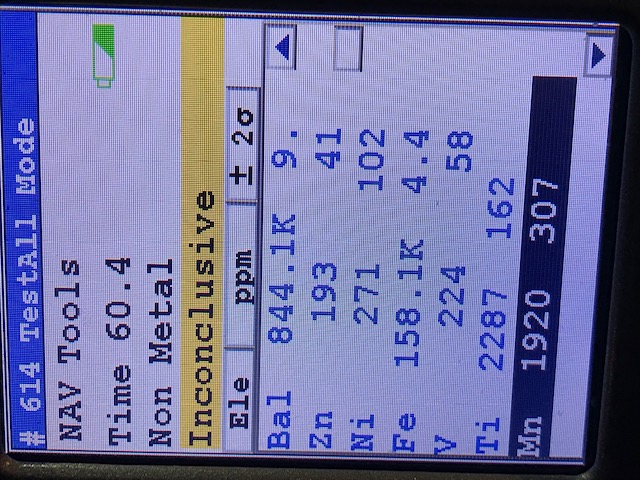








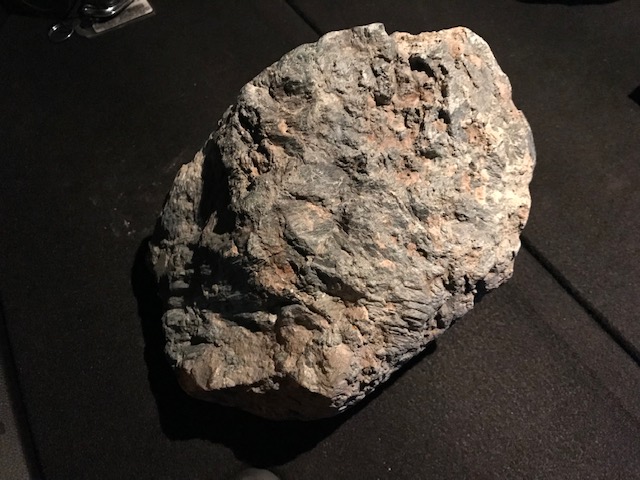


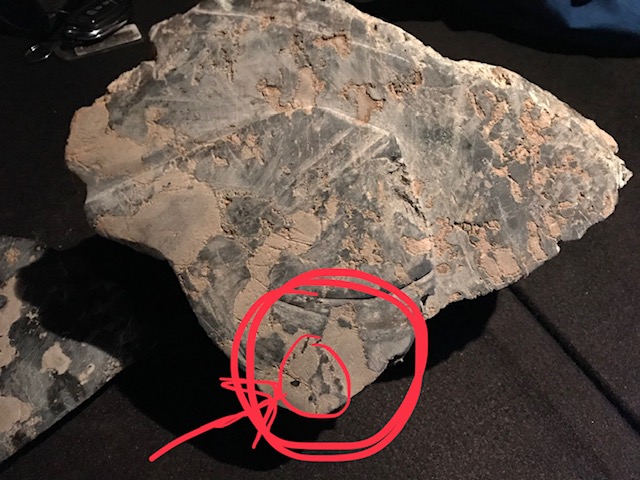


i have found a rock with seemingly the same elemental makeup, was it a meteorite? i found mine while cutting limestone from a creek to build a patio, in the middle of a rock
Hi, I have two stones. It is very close to your test sample. You may be in touch with me and help. Thank you very much
I have a crystal stone with a fusion shell. If it is possible, I will send my WhatsApp number with this message.